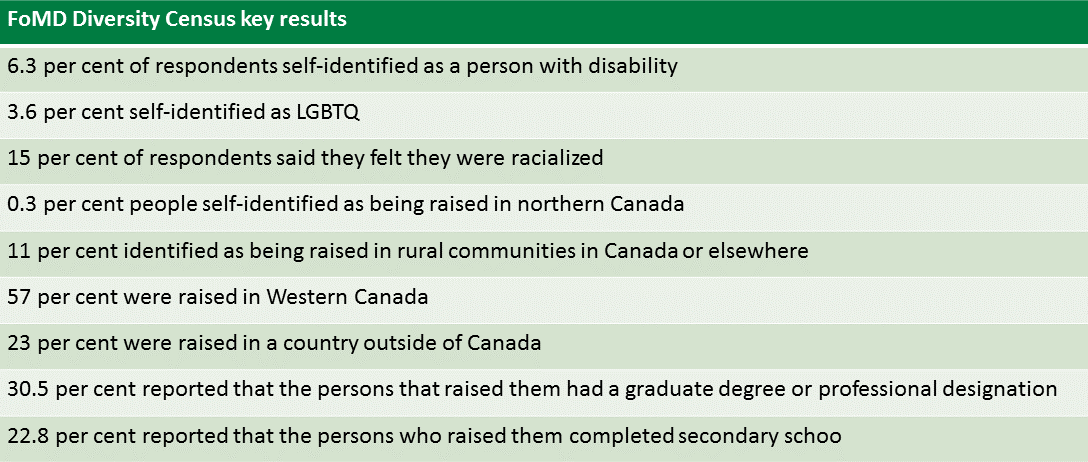
Helly Goez, assistant dean of diversity at the Faculty of Medicine & Dentistry, believes that asking questions about diversity is important.This led to to a pilot studying measuring the diversity of the FoMD.
Helly Goez's first step on the path of building a more equitable, diverse and inclusive faculty was to get a sharper snapshot of who we are.
"I believe that every journey of understanding diversity starts with asking questions," said Goez, the inaugural assistant dean of diversity at the University of Alberta's Faculty of Medicine & Dentistry. "If we are diverse, then how similar is our faculty's population to the general public that we serve?"
Goez's desire to shed light on different aspects of diversity in our workplace led to a pilot study―a campus first―that measured the diversity of the faculty's staff, academic and clinical faculty members on identity characteristics beyond the Employment Equity Act's four groups of Women, Persons with Disabilities, Members of Visible Minorities and Indigenous People. She worked with the Equity Diversity Inclusion (EDI) unit in Human Resource Services to launch the survey in the summer of 2017.
Goez says the team was pleasantly surprised with the survey response rate. The typical response rate for surveys is about 20 per cent. The total participation rate for the pilot diversity survey was around 41 per cent.
"The response rate was way higher than we anticipated, which means that people wanted to reply and to be part of it. For me, that's massive. When I saw that a cumulative 40 per cent replied, I really got emotional. I felt that people wanted to be represented and wanted to feel that they belong," said Goez.
"It's important to give people a place where they can say how they feel about equity, diversity and inclusion. In a way that is meaningful, they will be heard." -Helly Goez
Support staff, administrative and professional officers (APOs) and faculty service officers (FSOs) had the highest response rate at above 42 per cent.
For Goez, one of the most meaningful sections of the survey was the open comment section. For example, people added comments indicating that it is important to acknowledge invisible disabilities as well as visible ones. This information will be used in future surveys.
"It's important to give people a place where they can say how they feel about equity, diversity and inclusion. In a way that is meaningful, they will be heard," said Goez.
Are we diverse?
The voluntary survey posed questions addressing gender identity, sexual orientation, race and ethnicity, geographical background and socioeconomic status. The responses suggest that the faculty is diverse, but there are gaps that need improvement.

"Open discussions about equity, diversity and inclusion in the workplace are happening more frequently worldwide. It's like opening a box that was firmly closed for years, and now when opening it up, questions and concerns are raised," said Goez. "I view this as a natural process, and a healthy pathway that enables better dialogue and alignment with current societal concepts, leading to changes in policies and practices."
What picture does the data paint?
Goez says the section on racialized people provided data that the Faculty did not clearly have in the past.
"Racialization is a process in which social and biological markers like skin colour, cultural habits and religion are used to label a person as 'other'," said Goez. "This is about how people feel they are perceived as by others and can relate to how comfortable people feel within an organization."
The survey found that 23 per cent of employees who elected to respond self-identified as immigrants. Goez's team compared the data they received to data from Statistics Canada 2011 census. In 2011, 18 per cent of Alberta's population was at that time a visible minority.
Goez recognized that a variety of global factors have changed Alberta in the years since the 2011 census. When the full 2016 results are available, the FoMD results can be compared and assessed with the more recent data.
The Immigration and Ethnocultural Diversity Key results from Census 2016, released on October 2017, show that the percentage of new immigrants living in Alberta rose from 6.9 per cent in 2001, to 17.1 percent in 2016.
"Looking at this detailed census data allows us to hold a mirror to ourselves and see how closely we represent the community that we serve," said Goez.
FoMD census questions about geographical background helped to form a clearer sense of where responders come from.
"We wanted to see how many people come from rural communities," said Goez. "Worldwide, rural communities might have different and unique descriptors than urban population. For example, access to services and care might be different, so we wanted to capture it."
Another important factor Goez wanted to collect was the highest level of education obtained by the person or persons who raised the employee. Goez wanted the information to get an idea of people's socioeconomic backgrounds in alignment with the FoMD Diversity policy, and spent a lot of time together with members of the Office of Faculty Affairs committee constructing this question to make it as sensitive and inclusive as possible. It is important to mention that the voluntary census reflects intersectionality only as it relates to the employees that elected to participate.
Equity data is collected centrally on a monthly basis on all continuing faculty and staff by EDI, Human Resource Services (HRS). The 2017 FoMD response rate is 81.3 per cent, and 1.1 per cent of faculty and staff self-identify as Indigenous people, which is a slight increase from one per cent in 2015.
The HRS data shows that 1.4 per cent of FoMD employees identified as persons with disabilities, increasing from 0.8 per cent and 0.9 per cent in 2015 and 2007 respectively.
Additionally, 14.6 per cent identified as members of visible minorities in the past year, in comparison to 13.8 per cent and 4.7 percent in 2015 and 2007 respectively.
Based on PeopleSoft records, the percentage of women who are continuing faculty and staff in FoMD is 60.8 per cent, up from 56.2 per cent in 2015 and 50.6 per cent in 2007.
Where are the gaps?
The key identified gaps are currently within the groups of Indigenous people, persons with disabilities and women. The percentage of members of visible minorities seems closer to the population that the faculty serves, along with other metrics, and it will be important to conduct an intersectional analysis of these data.
"We do know that more people identified as Indigenous now than in 2012," said Goez. "We knew this is a gap, but this data will help us move forward."
Useful benchmarks for this new information are availability data for professors across all disciplines in the 2011 Census. Availability is a metric created nationally by Statistics Canada, through census information by occupation and self-identified employees. The current availability data is based on the 2011 Census and the 2016 Census availability data is forthcoming. For an example, the 2011 Census national availability factor for Indigenous Peoples at the professoriate level was 1.3 per cent. In 2017, the FoMD is at less than one per cent.
The 2011 census national availability factor for professors who are members of visible minorities is 19.1 per cent. This national data can be compared with the 2017 representation of 17.9 per cent in the FoMD, and 17.8 per cent across the University of Alberta.
For persons with disabilities, the national metric for professors showed availability of 3.8 per cent. The FoMD metric for 2017 is significantly lower at less than one per cent, while at the U of A is 1.8 per cent.
For women, the 2011 national availability for professors was reported at 43.3 per cent; in 2017, our Faculty measured 33.8 per cent, a number close to the university-wide statistic of 36.2 per cent women professors.
"All of this information serves as benchmarks, reflecting mirrors, and a compass in determining where we would like to be by comparing ourselves to our institutional variables, the population that we serve and the national availability markers," said Goez. "Most importantly, and although not always easy, we are able to recognize and talk openly about the gaps. We are asking the right questions honestly and sincerely and truly believe that this is the way to grow."
Where do we go from here?
Goez believes that the data opens up a whole variety of new questions about possible inequities that may exist and how to address them.
Now that there is a better sense of who we are as a faculty, Goez wants to work to find ways to nurture faculty and staff members in ways that are meaningful to them.
"We need to be aware of the well-being of people we hire to be part of the faculty, and how we groom them for promotion, for success, for happiness and satisfaction at work," said Goez.
The survey data also raises questions about the hiring process, pointing to an examination of whether our processes are as equitable and inclusive as they can be, and what we can do to support existing employees.
Improving diversity was a goal set out in the faculty's 2016-2021 Strategic Plan. To ensure the faculty hires on the basis of merit, Goez says that the FoMD leadership is reviewing hiring processes with an EDI lens.